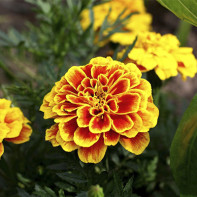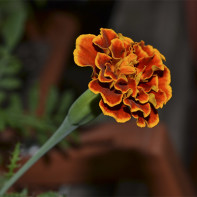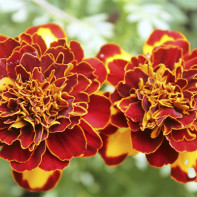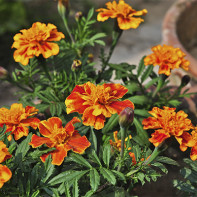Velvet: medicinal properties and contraindications
Velveeta is one of the most favorite plants of florists and landscapers. These flowers decorate garden plots, parks, gardens and boulevards from mid-June to the end of October, until the first frosts destroy the greenery.
- Chemical composition
- What they look like and where they grow
- How they look
- Where they grow
- Types
- Harvesting and storage
- Therapeutic properties of the marigold
- For Women
- For Men
- Slimming
- Velveeta in folk medicine
- For diabetes
- In pancreatitis
- For gastritis
- For bowel
- For constipation
- For the Liver
- For coughs
- For colds
- For Joints
- For Pressure
- For parasites
- For Eyes
- Healing Compounds
- Infusion
- Infusion
- Decoction
- Tea
- Oil of the marigold: properties and application
- Cosmetic applications
- Softening balm for lips
- Lotion
- Softening milk for face and body
- Oily skin and acne treatment mask
- Hair and scalp treatment
- Culinary Uses of Velveeta
- Salted Velveeta
- Shaker Lokum Cookies
- Original Salad with Seeds and Velveeta
- Pickled tomatoes and velveeta
- Salad of grapefruit and carrots with velveteen
- Can we give barhats to rabbits?
- Contraindications to use
Chemical composition
The leaf and flowers of the velveteen contain a large number of useful substances. Healing properties of the plant are recognized by official medicine, modern herbalists and healers use these flowers to treat many diseases. Chemical and mineral composition of marigolds is not fully studied, but the results of known studies give an idea of the usefulness of this plant.
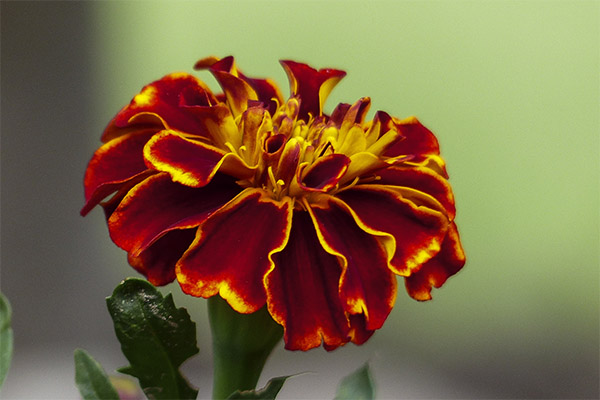
Velveeta contains a fragrant essential oil. This substance has a complex composition and has a tart, spicy floral smell with a fruity note. The oil is dark honey or yellow in color and is a mobile, fluid fluid. It contains many complex organic compounds:
- limonene;
- linalool;
- ocymene;
- myrcene;
- D-pinene;
- sabinene;
- D-terpinenes;
- citral.
The leading position is occupied by ocimene; this component makes up about 50% of the product. The composition and amount of essential oil varies in different species of marigold.
For example, leaves of small-flowered velveteen contain 0.28% of essential oils, in flowers - 0.45% on average. Oil production depends on the flowering phase. For example, buds contain from 0.22 to 0.3% essential oils, fully bloomed flowers - from 0.3 to 0.55%.
Dried plants contain vitamins and useful trace elements. In 100 g of dried product contains vitamins A (27 mg), C (80.8 mg), five B vitamins. Petals contain vitamins B1 (0.12 mg), B2 (0.27 mg), B6 (1.01 mg), B9 (93 mg), PP (1.46 mg). The flowers contain lutein and thiophene, which have a healing effect in a number of diseases. This plant contains ascorbic acid, rutin, flavonoids, carotene.
The caloric value of the dry product is 310 kcal per 100 grams. The same amount of raw materials contains:
- carbohydrates - 61,4 g;
- vegetable proteins - 11.1 g;
- fats - 5.8 g.
Velvet flowers contain a large number of useful trace elements. They contain iron, selenium, zinc, calcium, gold, magnesium, potassium.
How they look and where they grow
Among the vast genus of velvet grasses, there are tall and stunted species. Their representatives differ in the size of the flowers and leaves, the color of the petals, but they all have common features.
What do they look like
Flower stems are erect and strongly branched, adult plants form a spreading bush. The tallest velvets grow to 220 cm in height, and the shortest members of the genus - only up to 10 cm. The root system is taprooted, allowing the shrub to get water during long droughts. The root structure helps it survive in porous soils where moisture evaporates quickly. Florists plant velveteen in fertilized, drained soils. Under natural conditions, the flower does well in open fields and grassy slopes.
Leaf laminae can be toothed, pinnate separate and dissected, less often entire. Coloration of greens is often dark green, saturated. But there are varieties with light green foliage. The inflorescences of this plant are baskets with many small flowers, tubular or lingual. The color of the petals is burgundy, red, orange, brown, and even white. In many species, petal coloration is irregular, banded or spotted. The size of the inflorescent heads varies from one to 6 cm across. There are carnation-flowered species (the heads consist of tongue-like flowers) and chrysanthemum-like (with tubular flowers). All species of marigolds are divided into macerate, simple and semi-macerate.
The fruits of the plant contain a large number of seeds. One g of seed contains 250 to 700 seeds. Seeds are round and flattened, brown or black. There are annual and biennial varieties among the representatives of the genus Velvetvet.
Where to grow
Homeland of wild velvet plants is South and North America. Their range extends from the southern U.S. states (Arizona and New Mexico) to the plains of Argentina. Velvet flowers were brought to the Old World as early as the 16th century. The flowers are well established in Europe and Asia. Velvet plants are well tolerant of temperature changes typical of the midlands. Biennials are planted in the southern and temperate belt, where they successfully overwinter in the ground, as well as seeds that sprout "fall".
Species
The genus numbers 53 species. Most of the velvets planted in gardens and parks are hybrids. Among them there are both popular, recognizable and rare varieties.
Florists like the rich red Bolero, orange Hawaii and Mandarin, yellow Brocade Yellow and Lemon Drop, the varieties Striped, Orange Flame, Petite and Tiger Eyes. Vanilla and Kilimanjaro, topped with large white inflorescences, look great.
Gathering and storage
Only the inflorescences are collected for medicinal purposes. The flower heads should be in full bloom, and you can't pick unopened buds or wilted baskets. Dry the raw material under a canopy, on an open veranda, without access to direct sunlight. Velvets are collected in dry weather and try to dry when there is no rain and humidity levels are low.
You can collect not only inflorescences, but also leaves. To do this, the flowering shrubs are cut at a height of 15 cm from the ground and immediately put on to dry. Such raw materials also dried in a draught, under a tent or awning, without access to sunlight.
Shelf life of dry raw materials for 2 years. Keep dried flowers in a dark glass jar with a lid or in a cardboard box. Some collectors of medicinal herbs stored dried marigold in cloth sacks.
Therapeutic Properties of Velvet
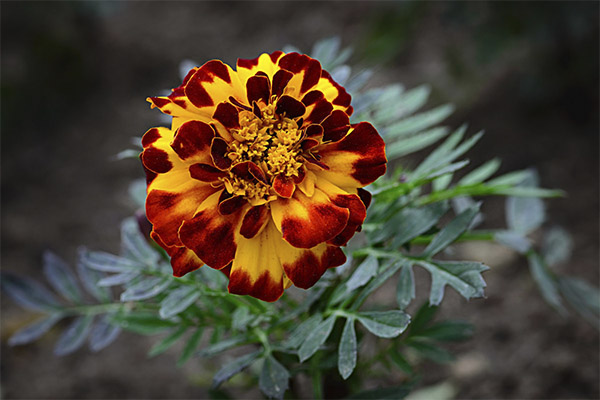
The medicinal properties of flowers are due to the organic substances and esters that make up the flowers and herbs. Preparations prepared on the basis of the plant, act on the body comprehensively and have the following effects.
- They destroy harmful bacterial flora and fungi;
- suppress inflammatory processes accompanying infectious diseases;
- increase metabolism;
- useful for activation of the kidneys, liver;
- Act as a diuretic, diaphoretic, anti-edema agent;
- Improve the digestive process;
- kill worms;
- Have a calming, relaxing effect;
- Stimulate tissue regeneration and have a healing effect;
- Helps eliminate intestinal cramps;
- Nourish the optic nerve and have a therapeutic effect on cataracts.
Beneficial effects on the eye and the nervous system of the eye has lutein. Lack of this substance is a cause of eye tissue degeneration. For the elderly, preparations based on marigold are useful for the prevention of clouding of the eye lens. This disease is called cataract, and an operation by an ophthalmic surgeon is required for a complete cure of the patient.
Lutein is a pigment that contains oxygen. It belongs to the group of carotenoids. A lack of this organic substance has serious consequences for the eyes. Therefore, means on the basis of velveteen recommended to use those who work a lot or just sit at the computer.
For women
Women are recommended to take decoctions, infusions and teas on velveteen with diseases of the genitourinary system, accompanied by inflammation. This is, first of all, cystitis. Therapeutic solutions are used for vaginal infections, for healing stitches after childbirth.
Infusions of marigold reduce the manifestation of premenstrual syndrome. The plant has a healing effect for irregular menstrual cycle, delayed periods. It is useful to take it and with a shortened cycle. In the absence of menstruation, you should visit a doctor to rule out pregnancy, and only then begin treatment with herbal remedies.
In every country of the world where velvet flowers are found, there are recipes for using these plants. In Mexico, for example, infusions of flowers are drunk by nursing mothers to increase milk production.
But European pediatricians hardly recommend preparations based on velveteen to activate lactation. This plant is rich in fragrant essential oils, and the baby may refuse to breastfeed.
For Men
In the treatment of inflammatory diseases of the male genital sphere, preparations from the velveteen can be recommended as an additional remedy. They are prescribed for acute inflammation, swelling, pain, skin rashes, redness of the skin and mucous membranes. In the treatment of pathologies occurring in both men and women, there are no differences in prescription, as well as in the external application for skin diseases.
When losing weight.
Active metabolism - the key to the effectiveness of any diet. Drinks made from marigold should be included in the diet as a diuretic, which in combination with plenty of water helps to improve the metabolism.
If you go to the gym during the diet, you can get rid of excess fluid in the body during exercise. Drinking a plant-based drink will have a diaphoretic effect and improve the result. Kilograms will "melt" much faster. Swelling will disappear, and the skin will look smooth and healthy.
During the diet, prepare a weak tea of marigolds, brewing a tablespoon of dried flowers per liter jar. A glass of liquid should be drunk during the day.
Velvets in folk medicine
Folk healers recommend remedies prepared from the velveteen, for many diseases. Ancient recipes have been proving their effectiveness for centuries. Often treatment with herbs can completely cure the disease. But a person should not refuse medication, in the first place should be the recommendations of doctors, not their own opinion.
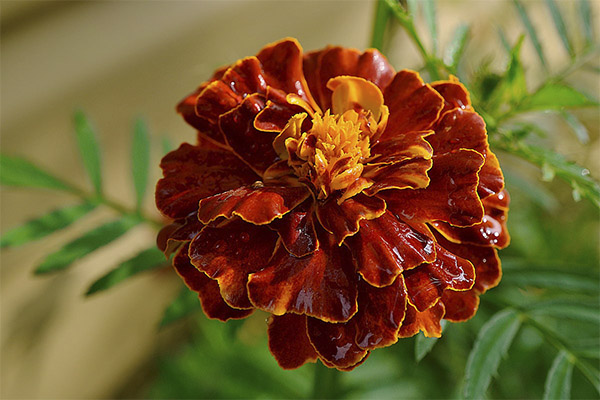
In case of diabetes
Patients with diabetes are recommended to take infusions, tinctures, teas from marigolds to stabilize glucose levels. The unique combination of substances included in this plant has a beneficial effect on the work of the pancreas.
It is better to use an alcohol tincture of small dark red velveteen. About 50 pieces of dried flowers are placed in a glass jar and pour vodka. You can take medical alcohol and dilute it with boiled water to 40 degrees. Vessel tightly closed and insist a week, putting in a dark place (in a kitchen cabinet or in a pantry where the sunlight does not penetrate). Then the jar is placed in the refrigerator. Vegetable cake is not removed. Drink the tincture with a meal three times a day.
When pancreatitis
Infusion for the treatment of pancreatitis can be prepared with a reserve, at once for three days. For this, you need medium-sized dried velvet flowers, 9-10 pieces (whole heads). The flowers are placed in a jar and boiled with freshly boiled water (1 liter). The jar is closed tightly with a plastic lid and wrapped with a thick terry towel.
In this condition the infusion incubated until completely cooled. Then open the vessel, remove the flowers and squeeze them into a jar. The solution is filtered through a filter paper or cloth, the vessel is sealed and put in the refrigerator for storage. Take half a shot all day every 2 hours.
With gastritis
With acute and chronic gastritis, the mucous membrane of the stomach becomes inflamed, and after each meal there is pain, abdominal discomfort and cramps. The substances contained in marigolds help to reduce the symptoms of the disease.
Folk healers recommend making a tea and drinking it daily. 3 medium or 2 large flowers (dry raw materials) are placed in a liter container, pour boiling water. After cooling, the remedy is ready for use. Tea is taken half a cup before meals twice a day.
For the intestines
Decoctions and infusions alleviate colitis and other intestinal diseases. To reduce inflammation, eliminate spasmodic pain and bloating, prepare a tea or make an infusion. For cooking, use dried or fresh flowers (2-3 velveteen average size). The remedy is prepared by pouring the raw material with boiling water and insisting until it cools. Colitis is a complex disease that requires a diet. Therefore, you should consult a doctor about the dosage of dry raw materials and the frequency of intake of the drug.
In constipation
For the treatment of constipation, weak infusions are prepared and drunk during the day. To prepare a remedy, it is enough to take one dried flower. Raw materials are crushed by hand and transferred to a glass of 250 ml. Pour boiling water. The glass can not be closed. This daily portion. It is drunk before meals during the day in 3-4 drinks.
For the liver
This decoction is prepared as a treatment for the liver and to improve metabolism. To prepare it, you will need 5 dried velvet flowers of small size. Raw materials are placed in a saucepan, add a liter of boiling water and boil on low heat for 3 minutes. The decoction is infused until completely cooled and strained, removing the floral raw materials.
Ready to remedy stored in the refrigerator. Recommended to drink 2 cups of broth a day, in the morning and at night. The treatment involves a course of 30 days. After that, make a one-week break and the course is repeated.
From coughs
To treat maxillary sinusitis, runny nose, bronchitis and a bad cough that accompanies colds, it is recommended to make inhalations with oil from the marigold. During inhalation, the vapors of essential oils easily penetrate into the respiratory tract.
In a heated ceramic kettle put 5 dried flowers of medium size and steamed them with boiling water. The vessel is covered with a thick towel and infused for 5-7 minutes. Then the steam treatment is started.
There are two variants of the treatment. Remove the lid of the kettle, bend your face over the steam and throw a wide towel over your head. Inhale the steam with the mouth and nose for several minutes. In another version of inhalation, the kettle is filled only to the spout opening. When the flowers are brewed and the remedy is infused, take the spout of the kettle to the lips, inhaling the steam through the mouth and exhaling through the nose.
With a cold.
With respiratory colds, it is recommended to drink teas and weak infusions on velveteen. They are made by brewing dried flowers with boiling water. Means on the basis of velveteen soothe, reduce pain and eliminate symptoms of general malaise.
When you have a cold, steep 3-4 large periwinkle in a liter jar and let the infusion to cool. The remedy is taken 3 times a day, half a glass with a meal.
Treatment is well supplemented by inhalation, as in the treatment of coughs and rhinitis.
For joints.
A rich, concentrated infusion is prepared to treat joint pain. You will need 23-25 fresh flowers of medium size. Flower heads are placed in a 1-liter jar and pour boiling water up to the neck. Close tightly with a lid and wrap in a blanket. Sustain means to a complete cooling. Then the blanket is removed, remove the flowers and squeeze them into the solution.
The infusion is strained into another vessel and drink instead of water, using from 1 to 1.5 liters per day. The course of treatment continued for 2-3 months. Dry ground raw materials are taken in smaller quantities - 4 tablespoons per liter jar.
From the pressure
To reduce blood pressure, it is recommended to prepare a complex infusion of several plants. To prepare 250-300 ml of remedy take 1 spoonful of dried raw materials. The collection includes:
- crushed marigolds;
- calendula flowers;
- peppermint leaves.
The herbal collection is placed in a vessel and poured just boiling water. Close the container and allow to stand for 15-20 minutes, then strain. Add honey and stir the liquid. The whole infusion is drunk before meals. If there is no experience in using an infusion of such a composition, you should try to drink a smaller amount of the remedy, 2-3 spoons.
From parasites
To expel worms and pinworms, it is recommended to eat 2-3 flowers of velveteen per day. Helminths do not tolerate the fragrant essential oil and in a week will disappear.
You can make a tea of herbs and heads. Finely chop 2-3 freshly cut leaves and 1 flower, pour boiling water (270-300 ml) and insist 40-45 minutes, then strain the liquid. Infusion is drunk up to 3 times a day, half a shot.
The same decoction helps to get rid of other parasites - fungi. Thiophene has an antifungal effect. This substance is good against pathogenic fungi, "settled" on the mucous membranes and in the lungs of a person.
For the eyes
To prevent and treat cataracts, you can use fresh flowers, just picked from the bush. It is enough to eat 3-4 flowers a day or add crushed petals to any dish. Dried petals can be chewed without brewing, a teaspoon each day.
Folk remedies based on marigolds also treat skin diseases, pustular rashes, warts, dermatitis, treat bedsores. Baths with decoction of velveteen have a good sedative effect.
Types of healing compositions
Folk healers prepare medicines from the velveteen through heat treatment of raw materials - fresh and dried flowers and leaves.
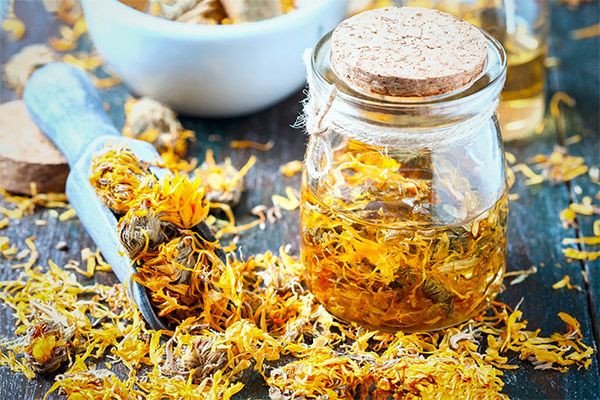
Infusion
When preparing infusions, whole or chopped heads of marigolds are placed in a small saucepan and brought to a boil in a water bath. It is not recommended to heat the liquid directly on the stove. The composition of the essential oil may change as a result of rapid heating. Often folk healers call a tincture a remedy that is not subjected to heating in a bath or on a stove, but simply brewed.
Tincture
The basis of the tincture is alcohol or vodka. Such remedies are prepared using fresh or dried velvet flowers, but the preparation from just plucked flowers and leaves retains much more essential oil.
A glass jar is filled up to half with fresh flower heads or put a few dried ones. Then pour the alcohol (vodka), seal the vessel and insist on the remedy for about 2 weeks (in a darkened room or in a closed cabinet). Store the finished tincture in the refrigerator.
Decoction
Aqueous decoction of marigold is prepared according to the same scheme as the infusion. The only difference is that the heat treatment takes longer.
To prepare a decoction, it is not enough to bring the water and raw materials to a boil in a water bath. You need to continue boiling for a few minutes to half an hour, or more. It is important to note that the velveteen more often prepared infusions and teas, but not decoctions, as with prolonged boiling essential oil is intensely evaporated.
Tea
Tea is made by steeping fresh or dried flowers with boiling water. Use a thick-walled glass or jar, cover the vessel does not close. The drink steeped for 3-5 minutes, after which the tea is ready for use.
Oil of Velvet: properties and application.
Oil based on velveteen has the same properties as infusions and teas. But the concentration of the essential component can be higher. It depends on the number of flowers used as raw materials.
The oil is used to treat joints, skin diseases and in aromatherapy. It is believed that the strong tart smell is useful to inhale in the treatment of neuroses, chronic anxiety and insecurity. The aroma of the velveteen relaxes the body and helps relieve tension.
You can make a therapeutic oil from the velveteen. The base is vegetable oil (olive, sunflower or other), the raw material is flower heads. The jar is filled with freshly cut flowers, pour lightly heated vegetable oil and leave in a dark place at room temperature for 7 days. The container is shaken every day. After a week, remove the flowers, squeeze into a jar and discard, and the oil is filtered and returned to the vessel. Add a new portion of fresh flowers. The process is repeated 3-4 times, after which the oil is finally strained into a bottle of dark glass, close hermetically and put on the bottom shelf of the refrigerator. Shelf life of the product - 2-2.5 months.
Cosmetic applications
Extracts of velveteen are part of the cosmetics produced by enterprises. These are, for example, facial tonic and hair dye with therapeutic effect from the Indian company Aasha Herbals.
The velvet flowers are used to make lotions, creams, balms and masks. Home remedies have toning, nourishing, softening, anti-inflammatory, antiseptic and rejuvenating effects on the skin. Cosmetic means are easy to prepare their own hands. Healing substances contained in the plant, relieve fatigue, treat acne, soothe irritation. Preparations based on flowers have a revitalizing effect on the hair and scalp.
Balm to soften the lips.
In a small cup with a rounded bottom, put 3 tablespoons of finely chopped fresh flowers. Pour one and a half spoons of apricot oil and 2/3 cup of olive oil, then whisk the ingredients until completely mixed.
The mixture is transferred to a jar, close the lid and insist for a week without access to light. After that, squeeze the raw material through a fine-mesh metal mesh or gauze, pour the oil into a small jar or plastic container. The balm is stored in the refrigerator and used as needed.
Lotion .
To prepare the lotion is made a water infusion. A tablespoon (above) of crushed dried flowers brewed with a little boiling water (0.5 cups). Insist under a lid for 12 hours, then pass through gauze folded in several layers. Plant squeeze.
Add half a shot of vodka and a teaspoon of freshly squeezed lemon juice. Ingredients thoroughly mixed. The lotion is ready. It can wipe irritated skin, treat inflammation and acne. If the skin is dry, after applying the lotion it is applied a nourishing cream.
Soothing milk for face and body
To prepare milk, make a decoction of dried raw materials. Measure a third of a cup of dried flowers and brew them with boiling water in a metal enamel bowl. Then place the pot in a water bath, heat the solution to boiling. Immediately remove the vessel from the bath, squeeze the plant material.
After the infusion cools, add a third of a cup of boiled water and freshly squeezed aloe juice. Take a large leaf to get 2-3 tablespoons of juice. The mixture is mixed and used to soften dry skin.
Mask for oily skin and acne treatment
To prepare the mask, make a concentrated infusion of fresh inflorescences of marigold.
Two flowers boiled (100-125 ml.). Insist 4-5 hours, then squeeze the flowers and strain the liquid.
Potato starch is diluted with the resulting broth so that you get a paste with the consistency of sour cream. Mass applied to washed skin and keep 10-15 minutes, then rinse.
Means for hair and scalp
Infusion of marigold rinse hair. Rinse liquid is prepared by brewing 2-3 spoons of dried flower heads with a liter of boiling water. When the solution cools and becomes warm, rinse the hair, pre-shampooed. If the scalp has dandruff, redness, rub the infusion lightly. It is recommended to do therapeutic rinses weekly.
Rubbing the oil of velveteen in the scalp strengthens the hair follicles. Regular massage is indicated as a therapeutic procedure for severe hair loss. The same effect has a rinse with decoctions.
The use of velvetveteen in cooking
The specific smell relates this plant to spices. Velvet leaves are used for pickling zucchini and cucumbers, pickling vegetables and fruits, canning tomatoes and other vegetables. Crushed petals are added to appetizers and vegetable dishes. Essential oil is used in the production of spirits. Colorful infusions of flowers are natural and safe food colorings. These products, as well as leaf powder, are in demand in confectionery factories and bakeries.
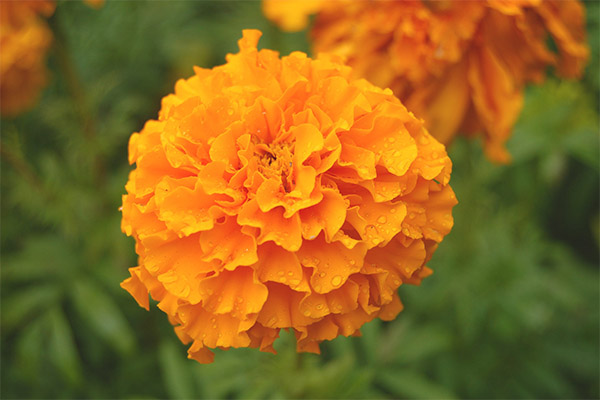
The petals of marigolds are used in food as a spice. Housewives have been harvesting these plants as a spice since summer. The flower heads are cut and dried, then crushed or ground into a powder. Stored in glass jars or boxes. Businesses are also engaged in harvesting. For example, the flowers of the two varieties of marigold (narrow-leaved and small-leaved) are the basis of the famous spice known as Imereti saffron. This powder is added to food to give it a golden color and a distinctive flavor. This spice is used to cook baked chicken, boiled rice, baked goods, and to color cream custards, drinks and other products.
Lovers of unusual flavors add Velveeta powder to canned and ordinary fruit and berry kissels. The flavor and smell of the flowers go well with other spices. The combination of velveteen, coriander and basil is popular in Turkish cuisine. This product is used to make homemade ajika by combining the petals of velveteen, garlic, chili, walnuts, coriander, seasoning with chopped suneli and vegetable oil.
Inflorescences can be preserved not only by drying. They can be salted and pickled.
Pickled Velveeta
Pour half a liter of water into a saucepan and dissolve 60 g of salt in it. Boil the brine for 5-7 minutes. At the same time prepare freshly picked flowers (1 kg). Flower heads are placed in jars and pour hot brine, close the lid and place the pickles in the cellar.
In the same way prepare pickled marigolds. In the marinade, in addition to salt, add sweet peppercorns and vinegar 5%.
Shaker lukum cookies
This pastry is a traditional dessert of Azerbaijani cuisine. To make the cookies you need to take:
- half a kilogram of white wheat flour;
- 200 g of butter;
- egg yolk;
- 50 ml of strong liquor (cognac, vodka, rum);
- 2 teaspoons of powder made from the petals of marigold.
Soften the butter and mash it with a fork. Add the flower powder and whisk the mixture until it is completely mixed. In a separate bowl beat the egg yolk with powdered sugar. Combine the butter and yolk, add flour and make a stiff dough. Then put "kolobok" on a plate and put in the fridge for 6-7 minutes.
Roll not more than 3 sm. thick from pieces of dough and press slightly to make 0,8-1 sm. thick flat cakes, put them on a non-stick baking tray. Bake the cookies in the oven at a moderate temperature for 6-8 minutes.
Original salad with seeds and marigolds
To prepare the dish, you will need fresh, resilient petals. A complete list includes the following products:
- 150 g of leaf lettuce;
- A teaspoon of linseed;
- A teaspoon of sunflower seeds;
- half a shot of olive oil;
- 3-4 inflorescences of marigolds;
- a few drops of balsamic vinegar;
- salt to taste.
Wash lettuce leaves, cut into ribbons or squares and place on a flat dish. Sprinkle evenly with sunflower seeds and linseeds. The petals of the marigolds are poured on top. The salad is sprinkled with vinegar, salted and dressed with olive oil. The ingredients are not mixed.
Pickled tomatoes with Velveeta
For this preparation you need petals and leaves of low-growing velvet flowers and small red tomatoes. You will also need cooking salt, granulated sugar and vinegar.
At the bottom of a sterilized liter jar put 2 medium flowers and a few leaves of velveteen. Densely arrange the tomatoes, add salt (to taste) and a teaspoon of sugar.
Boil water in a kettle and pour it into the jar, filling the container to the neck. Add 3-4 drops of vinegar, seal the jar, turn it upside down and cover with a thick towel. Leave the preparation in the upside down form until the jar cools. Store the pickle in the refrigerator.
Grapefruit and Carrot Salad with Velveeta
The aroma of the velveteen petals combines well with the smell and sourness of the citrus fruits. To prepare this unusual and healthy dessert you will need:
- A medium-sized grapefruit;
- 5 large inflorescences of marigold;
- small carrots;
- A teaspoon of olive oil;
- pinch of rosemary;
- salt;
- ground allspice.
The grapefruit is peeled, separated from each other and peeled, removing the white film. Then put the slices in a salad bowl. Carrots are peeled and shredded in fine julienne and also put into a bowl.
Remove the petals from the inflorescence and cut off the stalks with a sharp knife. This part of the petal is bitter, so it is better to remove it. Pour the petals into a salad bowl. Ingredients do not need to be mixed.
Pour the oil in a small bowl, pour there chopped rosemary, salt and allspice. The dressing is mixed well and poured over the salad.
Can I Give Velveeta to Rabbits
There are different opinions on whether or not rabbits should be fed velveteen. These animals have sensitive digestive systems adapted to certain foods.
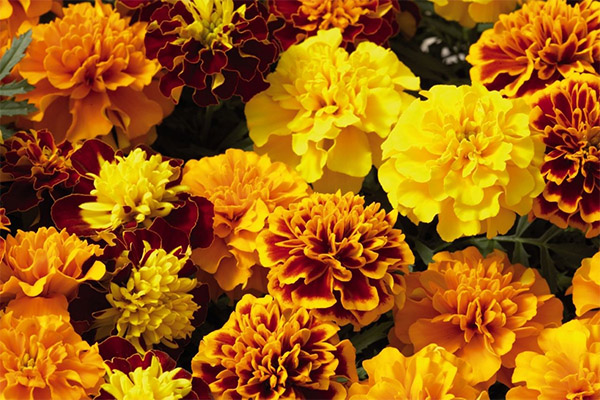
Velveeta, which has a pungent odor and is rich in fragrant essential oil, is not on the list of habitual foods for rabbits. You can read on the dachshund forums that amateur rabbit breeders do not advise feeding animals with this food. Others feed their rodents with velvets, but in moderation.
Professional breeders classify velvet plants as conditionally edible food, but even here opinions differ. Some write that the plant does not have any negative impact on the body of animals, does not slow down growth and does not reduce fertility, and essential oils improve digestion. Others advise against introducing this plant into the regular diet, using it only as a supplement. This applies to both conventional and ornamental rabbits.
Contraindications to use
Treatment with means from marigold is contraindicated if you are hypersensitive to the plant. Allergic reactions are manifested by rash, nausea, malaise, edema, life-threatening.
Pregnant women are not recommended to use folk remedies based on marigold. This includes all kinds of preparations for ingestion and external use. The action of essential oils and other active substances to the end is not fully studied, and there is no data on what effect they have on the fetus.
It is not recommended that children under two years of age should be given therapeutic products made from marigold. If there is any doubt about how and when to give decoctions and infusions to the child, you should consult with your pediatrician.
Velvet flowers - unpretentious flowers that do not require any care, except for weeding and infrequent watering. These flowers are not only a decoration of the garden, but also a medicinal plant and a delicious exotic spice.
«Important: All information on this site is provided for informational purposes only purposes. Consult with your health care professional before applying any recommendations. specialist before using the recommendations. Neither the editors nor the authors shall be liable for any possible harm caused by materials."

